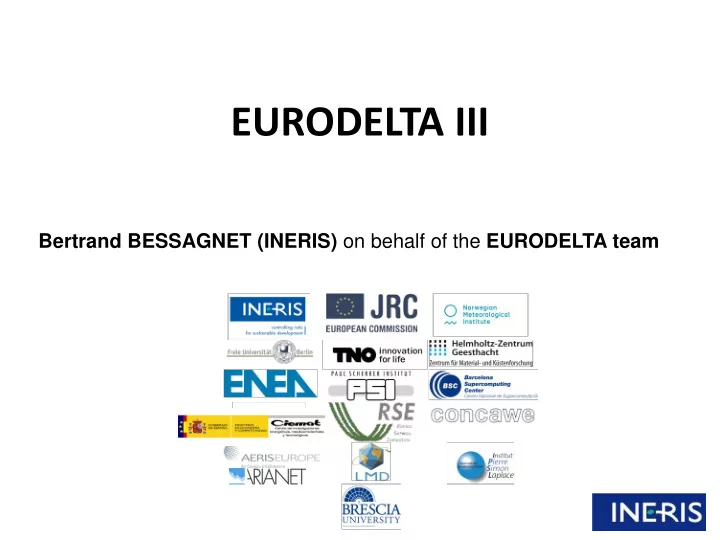

EURODELTA III Bertrand BESSAGNET (INERIS) on behalf of the EURODELTA team
B. Bessagnet, A. Colette, F. Meleux, L. Rouïl, A. Ung, O. Favez (INERIS) P. Thunis (EC JRC) C. Cuvelier (ex. EC JRC) S. Tsyro (Met Norway) R. Stern (FUB) A. Manders, R. Kranenburg (TNO) A. Aulinger, J. Bieser (HZG) M. Mircea, G. Briganti, A. Cappelletti (ENEA) G. Calori, S. Finardi, C. Silibello (ARIANET) G. Ciarelli, S. Aksoyoglu, A. Prévot (PSI) M. ‐ T. Pay, J. M. Baldasano (BSC) M. García Vivanco, J. L. Garrido, I. Palomino and F. Martín (CIEMAT) G. Pirovano (RSE) P. Roberts, L. Gonzalez (CONCAWE) L. White (AERIS EUROPE) L. Menut (LMD, IPSL, CNRS) J. ‐ C. Dupont (IPSL, CNRS) C. Carnevale, A. Pederzoli (UNBS)
The Eurodelta III exercise • Two phases : 1. Simulation of intensive measurement campaigns • 1 Jun ‐ 30 Jun 2006 (Summer) • 8 Jan ‐ 4 Feb 2007 (winter) • 17 Sep ‐ 15 Oct 2008 (fall) • 25 Feb ‐ 26 Mar 2009 (winter) • Evaluation & clues to improve models 2. Retrospective analysis (2008, 1999, 1990) • Ability of models to reproduce the difference of concentrations for the three key years, how models work under different chemical regimes • Starting point of the « Trend analysis » exercise • Common inputs for models : meteorology (IFS), emissions (EC4MACS dataset), boundary conditions (MACC), domain (except CMAQ) CAMx ( PSI/RSE ), CHIMERE ( INERIS ), CMAQ ( HZG ), EMEP ( Met.no ), LOTOS ‐ • EUROS ( TNO ), MINNI ( ENEA ), RCG ( FUB ) • Others participants: – DG JRC , CIEMAT , BSC , IPSL ‐ CNRS , UNBS , NILU, ARIANET – TOTAL, CONCAWE, LWA
Status of the exercise • Start of the exercize in April 2012 • April � June 2012: work on input data • June � October 2012 : work on models • Year 2013 : production of runs (2006, 2007, 2008, 2009) and first discussions on results • Mid ‐ 2013 � Begin 2014 : draft of the report for the 2009 campaign • Mid ‐ 2014 � Mid 2015 – start of retrospective analysis on 3 key years coupled to Trend analysis (1990 ‐ 2010) – Publication phase for the campaigns
Part I : Intercomparison exercises • Chemistry : � usual regulatory pollutants (PM10, PM2.5, O3, NO2, SO2) � PM compounds on daily and hourly bases � Depositions (wet S, N) � O3 profile • Meteorology : � PBL � Temperature � Wind speed
Mean PM10 ‐ 2009
Target plot for PM10 in 2009 (EMEP) with delta tool % of station that fulfil the criteria: EMEP 84%, CHIMERE 73 %, LOTOS-EUROS 78 %, RCG 78%, CAMX 60%, MINNI 69%, CMAQ 69%
Mean PM10 ‐ 2006
Coefficient of variation for PM10 ENSEMBLE= AVERAGE( EMEP, CHIMERE, CAMX, LOTOS ‐ EUROS, MINNI ) 2009 2006 Cv = Sd/M
Error : PM10
Correlations
Chemical regime of models for SIA formation (Gratio for the free NH3) G ratio > 1 means exces of ammonia
Modelled SOA versus OOA measurements
POM from SNAP2 versus BBOA measurements
Main outcomes for the 2009 campaign Important variability of model results for PM (processes, biogenic • emissions, diagnosed meteorology) • Use of IFS field rather questioning (biases on the wind speed) • The models are too flat (PM gradients) • More similar patterns for SIA between models • Underestimate of OM, a factor of 2 to 6 during episodes particularly in wintertime: – Chemistry of POA – POA emissions • A group of models underestimate the peaks of ammonium nitrate while the other overestimate total nitrate • Good behaviour of models including advanced wind blown dust modules • Co ‐ analysis of deposition and concentrations (Gas and particles) was fruitful to understand the model behavior
Recommend
More recommend